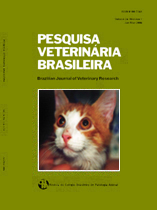 |
|
|
|
Year 2010 - Volume 30, Number 2
|

|
A and B mode ultrasonography in preopera-tive evaluation of lens and posterior segment of dogs eyes with cataract, 30(2):121-126
|
ABSTRACT.- Martins B.C., Rodrigues Jr E.F., Souza A.L.G., Almeida D.E., Brito F.L.C., Canola J.C., Brooks D. & Laus J.L. 2010. A and B mode ultrasonography in preopera-tive evaluation of lens and posterior segment of dogs eyes with cataract. Pesquisa Veterinária Brasileira 30(2):121-126. Departamento de Clínica e Cirurgia Veterinária, Faculdade de Ciências Agrárias e Veterinárias, Universidade Estadual Paulista, Jaboticabal, SP 14884-900, Brazil. E-mail: jllaus@fcav.unesp.br
Ultrasonography of the lens and posterior segment is an indispensable step in the preoperative evaluation of dogs with cataracts, since ophthalmoscopy is not feasible when there is opacification of the lens. This study evaluated the echographic conditions of cataractous lens and fundus of the eye in dogs affected by cataracts. The study was conducted in 30 dogs (56 eyes), 10 males and 20 females, with different types of cataracts at different stages of development. Echography in A and B modes, simultaneously, was carried out for the examination of the lens and posterior segment. The examinations revealed anterior cortical, posterior cortical and nuclear cataract in 12 eyes (21.4%), anterior cortical, posterior cortical, nuclear and posterior capsular in 23 eyes (41%), anterior cortical, posterior cortical and posterior capsular cataract in one eye (1.7%), anterior cortical and nuclear cataract in one eye (1.7%), anterior cortical, nuclear and posterior capsular cataract in five eyes (8.9%), and anterior cortical cataract in seven eyes (12.5%). Abnormal ultrasonographic alterations were observed in the posterior segment in 26 eyes evaluated (46.4%). Vitreal degeneration was detected in 12 eyes (21.4%), images of vitreal exudate or hemorrhage in seven eyes (12.5%), persistence of hyaloid artery in four eyes (7.1%) and lens subluxation in three eyes (5.3%). The results obtained reiterate the importance of ultrasonography in canine patients presented for cataract surgery given that alterations of the posterior segment are difficult to identify in a clinical examination when the lens is opacified. |
| |
|
|
| |
|
 |